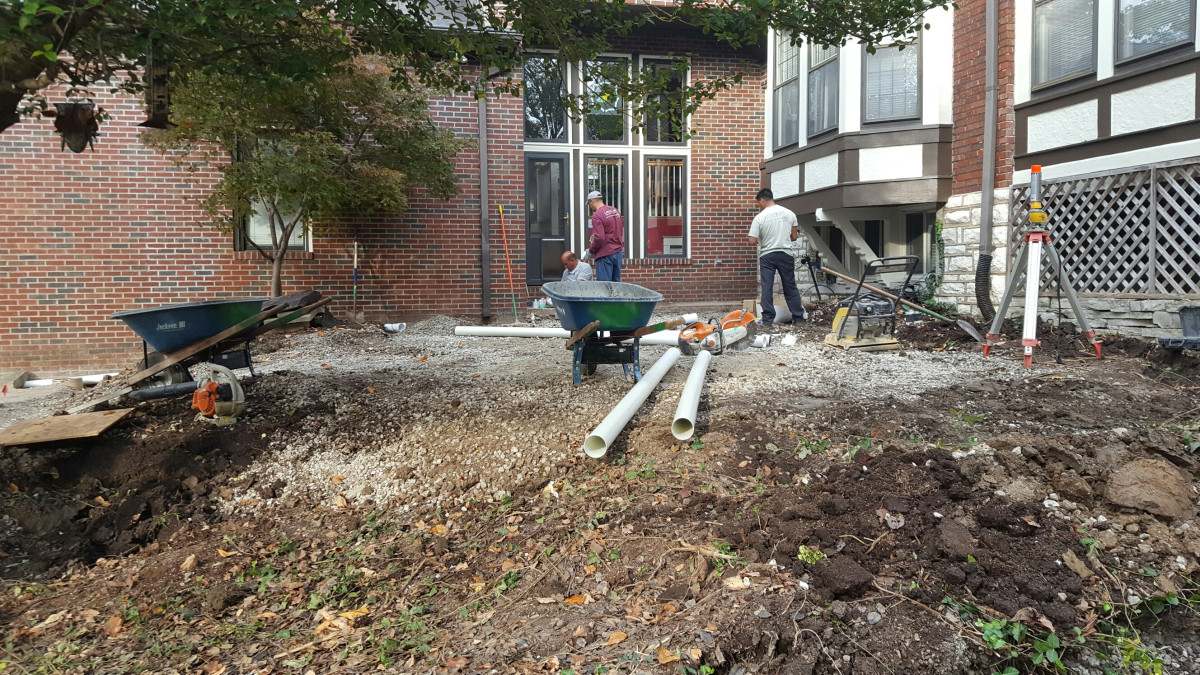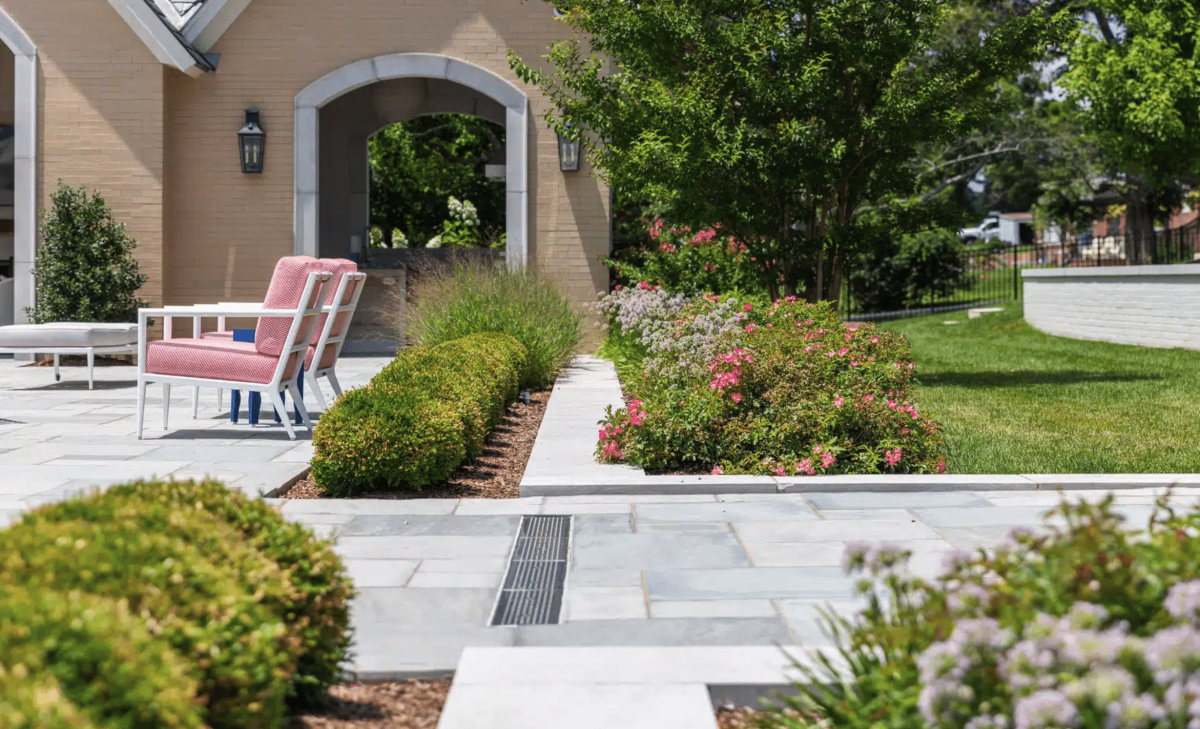The characteristic heavy precipitation patterns of late autumn throughout the St. Louis region serve an unexpected diagnostic function for residential properties, according to landscape professionals working in premium communities. November's substantial rainfall events reveal drainage deficiencies that remain hidden during drier summer months, creating a critical window for homeowners to identify and address problems before winter conditions make corrections impossible.
Properties throughout Ladue, Frontenac, and Town & Country experience particularly acute drainage challenges due to the region's clay-heavy soil composition and the sophisticated hardscape installations common in upscale landscapes. What appears as minor water accumulation during autumn storms often signals more serious grading issues that threaten both landscape health and structural integrity. Understanding how fall landscape conditions reveal underlying problems helps homeowners protect their substantial property investments.
Recognizing Drainage Warning Signs
Many homeowners dismiss standing water or slow drainage as normal consequences of heavy rainfall. However, properly designed and maintained landscapes should channel water efficiently away from structures and planting areas regardless of precipitation intensity. When water pools consistently in specific locations, flows toward rather than away from foundations, or creates visible erosion patterns, underlying drainage deficiencies demand attention.
The clay soils prevalent throughout premium St. Louis properties compound drainage challenges significantly. Unlike sandy or loamy soils that absorb water readily, clay becomes nearly impermeable when saturated. This characteristic creates conditions where surface water has nowhere to go, leading to pooling that persists for days after precipitation events end.
Fall timing makes these issues particularly visible for several reasons. Deciduous trees have dropped most foliage by November, eliminating the canopy interception that reduces apparent rainfall reaching ground level during summer months. Lawn dormancy means turf absorbs less water than actively growing grass. Cooler temperatures slow evaporation rates, causing water to remain visible longer. Combined, these factors make November storms remarkably effective at revealing drainage deficiencies homeowners might never notice during other seasons.
Foundation risks represent the most serious consequence of poor drainage. Water that flows toward homes rather than away creates hydrostatic pressure against foundation walls, potentially causing cracks, moisture infiltration, and structural settling over time. The financial implications of foundation repairs dramatically exceed costs associated with proper drainage correction, making early intervention economically prudent beyond landscape protection concerns.
Understanding Drainage System Components
Effective residential drainage relies on multiple integrated components working cohesively. Surface grading provides the first line of defense, with properly sloped terrain directing water away from structures toward designated drainage areas or collection points. Even subtle grading errors of just a few inches over several feet can reverse intended flow patterns, creating problems that worsen over time.
French drains address subsurface water movement, collecting groundwater through perforated pipes surrounded by gravel and filter fabric. These systems work invisibly when functioning correctly but fail gradually as silt infiltration clogs perforations or root intrusion blocks pipes. Fall storms stress French drain capacity, revealing systems operating at diminished efficiency that may fail completely during winter freeze-thaw cycles or spring snowmelt.
Downspout routing determines whether roof water becomes an asset or liability. Many properties discharge downspouts directly adjacent to foundations or into areas where water has no clear exit path. Professional drainage design routes roof water through underground pipes to appropriate discharge locations, preventing the concentrated flows that cause erosion and foundation concerns.
Retaining walls serve dual purposes of creating usable terraced space while managing water movement on sloped properties. However, walls built without proper drainage provisions trap water behind them, creating hydrostatic pressure that causes bulging, cracking, and eventual failure. Weep holes and drainage aggregate behind walls allow water escape, but these features require proper installation and ongoing maintenance to function effectively.
Comprehensive Drainage Solutions
Professional drainage correction begins with thorough site analysis during or immediately after substantial precipitation events. Walking the property during active rainfall reveals flow patterns, pooling locations, and erosion development that may not be apparent during dry conditions. This diagnostic approach identifies root causes rather than addressing symptoms, ensuring corrections actually solve underlying problems.
Regrading represents the most fundamental drainage correction, though it requires expertise to execute without creating new problems elsewhere. Professional grading establishes appropriate slopes—typically minimum two percent grade away from structures—while maintaining aesthetic transitions that don't appear artificially manipulated. For properties with existing mature plantings or established hardscape, selective regrading addresses problem areas without requiring wholesale landscape reconstruction.
French drain installation provides subsurface water management where surface solutions prove insufficient. Proper installation requires correct pipe sizing, appropriate gravel selection, quality filter fabric placement, and adequate slope to designated outlets. Poorly installed French drains often cause more problems than they solve, highlighting the value of professional expertise over DIY attempts.
Catch basins collect surface water at low points, channeling it through underground pipes to suitable discharge locations. These systems prove particularly effective for paved areas, patio surrounds, and other hardscape installations where surface grading options are limited. Strategic catch basin placement intercepts water before it reaches vulnerable areas, providing proactive protection rather than reactive damage control.
Experience and Regional Knowledge
Landscape St. Louis has addressed drainage challenges throughout the region since the company's founding in 1987. Nearly four decades of experience encompasses extreme weather events including the historic 1993 floods, the 2008 Midwest flooding, and numerous severe storm seasons that tested drainage infrastructure across thousands of properties.
This accumulated expertise recognizes that effective drainage solutions must account for St. Louis-specific conditions. The region's clay soils, periodic intense precipitation events, freeze-thaw cycling, and variations in water table depth all influence drainage system design and performance. Generic solutions developed for different regions often fail when applied to local conditions without appropriate modifications.
The company's systematic approach integrates drainage considerations into all aspects of landscape design and maintenance. New hardscape installations incorporate appropriate grading and drainage infrastructure from initial planning stages. Seasonal maintenance includes drainage system inspection and cleaning. Design consultations for property enhancements evaluate existing drainage adequacy, addressing deficiencies before they compromise new investments.
Long-term client relationships developed over decades enable Landscape St. Louis to understand individual property histories, previous challenges, and solutions that have proven effective. This institutional knowledge proves invaluable when diagnosing complex drainage issues that may stem from corrections attempted years earlier by less knowledgeable contractors.
Specialized Services for Premium Properties
Properties in communities like Town & Country and Huntleigh often feature sophisticated outdoor environments with multiple terraced levels, extensive hardscape installations, and valuable specimen plantings. These complex landscapes require drainage solutions that protect investments while maintaining aesthetic integrity that justifies premium property valuations.
Integrated drainage design coordinates with other landscape elements rather than treating water management as an afterthought. Retaining walls incorporate proper drainage provisions from initial construction. Patio installations include subtle grading and discrete drainage channels. Planting bed design accounts for water movement patterns, positioning moisture-loving species in naturally wetter areas while protecting sensitive specimens from excess water exposure.
Professional landscape design and build services prevent the drainage problems that often result from piecemeal landscape development. When multiple contractors work on properties over time without coordinating efforts, drainage conflicts frequently develop as each addresses their immediate scope without considering broader water management implications. Unified design and execution ensures all elements work together cohesively.
Values and Client Service
Transparency characterizes the company's approach to drainage problem diagnosis and correction. Rather than proposing extensive work based on assumptions, professional assessment identifies actual issues and their causes before recommending solutions. Some drainage problems require significant correction while others need only minor adjustments. Honest evaluation serves client interests over maximizing project scope.
Education empowers homeowners to recognize warning signs and understand their landscape's drainage characteristics. Clients learn what to watch during storm events, when seasonal drainage inspection makes sense, and how routine maintenance protects drainage infrastructure. This knowledge transfer builds confidence that landscape investments receive appropriate ongoing care.
Response reliability proves especially valuable during drainage emergencies. Storm events that overwhelm inadequate drainage systems often occur during evenings or weekends when homeowners most need professional guidance. Established relationships with responsive service providers provide peace of mind that problems receive prompt attention when they arise.
Taking Appropriate Action
November's remaining weeks offer homeowners throughout the St. Louis region opportunity to address drainage issues before winter conditions halt correction work. Early identification and professional assessment position properties for spring correction if immediate work proves impractical, ensuring solutions are ready for implementation at the earliest appropriate time.
The investment in proper drainage correction protects much larger investments in homes, landscapes, and property values. Foundation repairs, hardscape reconstruction, and plant replacement resulting from drainage failures cost multiples of what proactive correction requires. More importantly, adequate drainage eliminates the stress and inconvenience of recurring problems that disrupt property enjoyment and create constant concern during precipitation events.
Landscape St. Louis continues serving premium residential properties throughout the region with drainage expertise developed over nearly forty years of regional practice. Property owners concerned about water management issues or seeking professional evaluation of their landscape's drainage adequacy can reach the firm at 314-876-8064 or visit landscapestlouis.com for comprehensive information. Fall's revealing rains provide the diagnostic opportunity. Professional assessment and correction ensure properties weather winter successfully while preparing for spring's beauty.




